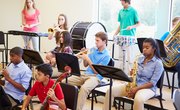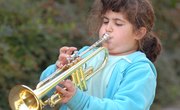Art and music programs in public schools provide much more than a break from academics or a fun extracurricular activity. According to the advocacy organization Americans for the Arts, arts education can help kids to stay in and succeed in school. While there is little debate that students who consistently take art and music classes during high school have better academic and personal outcomes, budget cuts often win out and eliminate these programs. From finding other sources of money to private fund-raising, there are ways teachers and families can save the arts in school.
Background
If you think that your child or your school is entitled to have arts education programs, you may need to think again. Although, according to Americans for the Arts, the federal Elementary and Secondary Education Act includes the arts as "core academic subjects," schools may push painting, orchestra, band and other similar programs aside in favor of reading, writing and math classes. In a Common Core survey of 1,001 third- through 12th-grade educators, 66 percent of teachers believe that subjects such as the arts are being downsized due to an overwhelming emphasis on language arts and mathematics. Between the increasingly higher importance on the more "academic" subjects and less money to spend on education, it isn't surprising that schools are seeing major cuts to art and music programs.
Professional Development
Before jumping to the conclusion that arts funding equals money for supplies or equipment, keep in mind that professional development opportunities provide a valuable tool for teachers to learn about new methods and best instructional practices, Cuts in art and music programs often mean that teacher training is eliminated due to a lack of funding. Instead of throwing in the towel, schools, administrators and individual educators can apply for grants that go directly toward professional development funding. If your school won't pay for a workshop at the local art museum or to have a professional musician come to in-service training, the U.S. Department of Education's Arts in Education program for Professional Development for Arts Educators provides thousands of dollars -- the individual amounts vary depending on the school, program and availability of funds -- for teacher training. Additionally, smaller grants and awards, such as the National Art Education Association's $2,500 Ruth Halvorsen Professional Development Grant, can help out when budget cuts come into play.
Program Funding
When schools threaten to cut art and music from the curriculum, it often means there simply isn't enough money to pay teachers and buy supplies. One solution to arts program cuts is to find alternative sources of funding. Similar to finding funding for professional development, government and private grant money can help to keep a fragile arts program afloat. For example, the National Endowment for the Arts provides funding for art education programs that are standards-based and reach children ages 5 through 18. Likewise, other organizations -- for instance, the National Art Education Association -- offer funding, such as the Teacher Incentive Grant, for educators to use for implementing and assessing school art programs.
Private Sources and Fundraising
What happens if your school cuts its arts funding and you can't find a grant that fits your needs? Don't discount your own fundraising efforts or your ability to find funds from private sources. Start small with a student-led community effort. For example, if the school cuts the funding for your art club -- leaving you no money to take an annual trip to the museum -- stage a community art show and auction off the student's work to solve your problem. Take a look at how the PTA, sports associations and other school-related groups get together and raise funds, and learn through their efforts. Sell candy bars, have a car wash or throw a fundraising event to contribute to your school's art and music programs. While these methods most likely won't pay a teacher's salary or buy the band all new instruments, they can help to supplement a dwindling budget or allow the students to participate in arts-related activities such as competitions, recitals and field trips.
Related Articles
References
Writer Bio
Based in Pittsburgh, Erica Loop has been writing education, child development and parenting articles since 2009. Her articles have appeared in "Pittsburgh Parent Magazine" and the website PBS Parents. She has a Master of Science in applied developmental psychology from the University of Pittsburgh's School of Education.











